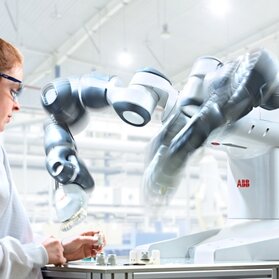YuMi: ABB’s dual-arm robot ushers in new era of human-robot collaboration
YuMi boosts electronics makers’ flexibility while working safely with humans to unlock new manufacturing potential.
Inside ABB’s Low Voltage Products factory in Västerås, Sweden, the company’s new dual-arm robot, YuMi, was put into operation in 2014, working safely and without protective fences alongside people to assemble devices including push buttons for industrial customers to help control electricity.
With its gripper-equipped hands, YuMi’s tasks included assembling devices before putting them into boxes of 500, with human operators replenishing feeders and performing other work. For other orders, YuMi could be swiftly reconfigured to do initial assembly on components before handing them to a person to complete the job.
Ivan Lundberg, the principal engineer for collaborative assembly in Sweden who helped develop YuMi, says the robot has been designed to shift nimbly from task-to-task because programming it is nearly as simple as telling a human what to do. It is a process more akin to teaching, where a co-worker simply moves YuMi’s arms and hands, using his or her own arms and hands, logging waypoints and gripper actions on a paired tablet running the YuMi app.
What this means for manufacturers of computer, communication and consumer electronics devices is YuMi requires far fewer engineering resources to accomplish very complicated tasks than would less-flexible, fully automated assembly lines.
“The robot can be easily repurposed to work in different production modes, a good example of how the flexibility of a collaborative robot can be put into practice,” Lundberg said. “We only need to automate the key steps and can thus do it more simply and with less investment than a fully-automated line.”
Transforming the paradigm
Since ABB introduced the first commercial microprocessor-controlled electric industrial robot, the IRB 6, in 1974, the form and function of industrial robots is little changed.
YuMi, being officially introduced to the world at the Hannover Messe 2015, is designed to transform this paradigm, working safely and collaboratively with people without cages that previously separated human workers from machines and limited this relationship from reaching its full potential.
YuMi is also a natural extension of the possibilities offered by the Internet of Things, Services and People, since a wireless link can be used to program robots’ positions on the assembly line. Once commissioned, the robot can be tracked via ABB’s sophisticated remote monitoring services to make sure everything is functioning as intended.
This dual-arm robot will usher in a new era for electronics manufacturers, whose assembly factories are facing dual pressures of skyrocketing demand and limited supplies of skilled labor that are driving them to seek new solutions.
That is why YuMi was developed: To help surmount challenges including labor shortages and employee retention while improving assembly processes – and ensuring workers stay out of harm’s way.
Opening doors to automation - safely
With integrated, padded arms that each flex at seven axes and camera-equipped hands to pick and place parts precisely, YuMi can learn quickly from its human colleagues. This so-called “Lead-Through Programming” can turn what was once hours of tedious programming into a few minutes of easy work.
“This just opens the door for anybody to automate, from a large factory to small business owners,” said Phil Crowther, ABB Robotics, Product Manager Small Robots. “Then you get all the benefits of automation - quality, less wastage, energy saving and better ROI.”
People may sit side-by-side with the YuMi, performing similar tasks.
Alternatively, the robot may assemble a device for the person to inspect for quality before placing it in a box for shipment. In some instances, the person will face the robot and feed it with parts, with YuMi then tirelessly repeating a delicate task that, over and over again, may be too taxing for human hands.
With YuMi, people will become more essential for jobs requiring cognitive and technical skills, while the robot will take over more of the delicate, dull, dirty and dangerous jobs in small-parts assembly – while still guaranteeing humans can work nearby without concern for their safety.
‘Endless options’
“The options are endless,” Crowther added. “The key is to use the robot for its performance, repeatability and accuracy and use the person for the skills they have, like touch and feel.”
ABB has also developed a sophisticated parts-feeding system, the FlexFeeder™, to store a large number of parts awaiting assembly. Picking these parts, once a complex challenge, has been simplified by the FlexFeeder through its ability to serve those parts from the bin in small numbers onto a flat surface.
It is here that YuMi’s integrated hand cameras can easily locate and then direct grippers or suction cups to pick parts and manipulate them to fulfill the task at hand.
For interactions with human coworkers, YuMi’s pinch points are eliminated, protecting fingers or clothing from becoming entrapped. The slightest contact with a human co-worker prompts YuMi to rapidly diagnose the situation; if necessary, its motor shuts down in milliseconds – and can be restarted by simply pressing a button.
“The inherently safe design allows for operators to work closely together, side-by-side, without additional safety equipment,” said Lundberg. “That saves engineering and investment costs.”
source: ABB




